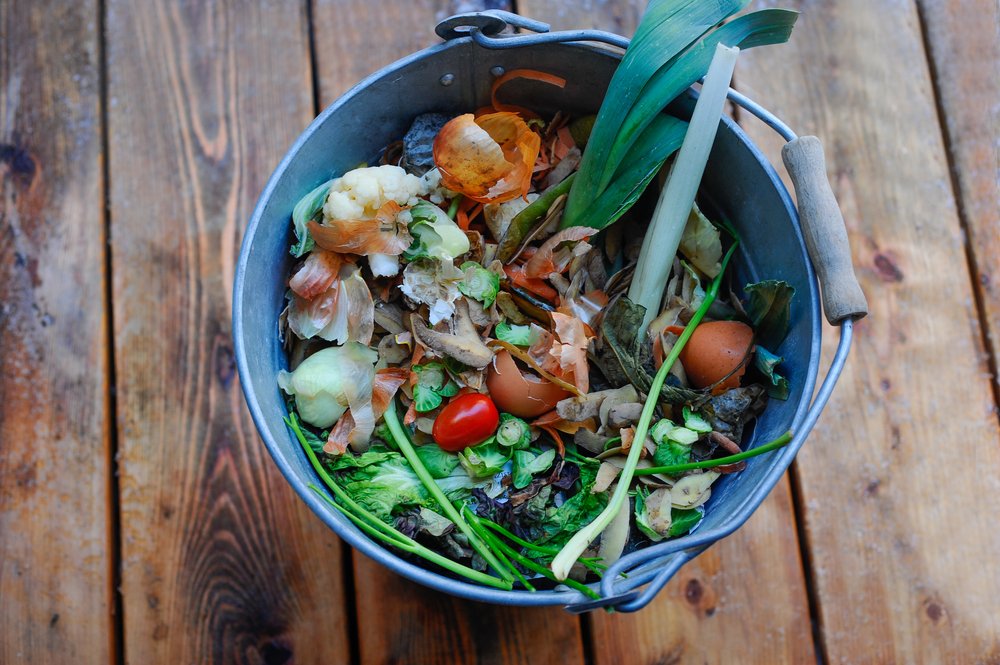
Authored By: Cat Ebeling
Food waste is on most everyone’s minds these days, and if you are buying expensive, but healthy organic veggies, you definitely need to make the most out of your purchases.
Did you know that some of the healthiest parts of fruits and veggies are ending up in your trash can? We cut, skin, and slice away some of the most nutritious parts of these foods. Let’s take a look at the top most nutritious food ‘scraps’ that normally get tossed into the trash. Eating all the edible parts of fruits and veggies may end up helping you save tons of money on your food budget, AND packing in more nutrition per bite!
Note: It is highly advisable if you are eating veggie skins, tops and other scraps to be sure to buy organic, and local if possible. And of course, always be sure to wash well. Some of the most concentrated forms of pesticides can reside in skins, tops, and rinds of conventional veggies. Some skins, even if organic, may contain oils, waxes or other finishes to protect the fruit or vegetable, so be sure to wash well.
1. Carrot Greens/Tops
If you buy your carrots fresh, by the bunch, instead of in a bag, you know they have long, lush, green and bushy tops. And fresh-picked carrots have especially beautiful green tops. Can you believe we throw those lovely greens away? Like most greens, these greens contain tons of nutrition and fiber.
Carrot greens can be chopped up and used like parsley sprinkled on your potatoes, veggies or soup, or added to a salad. Packed with potassium, chlorophyll, magnesium, and vitamin K, this ‘rabbit food’ helps to lower blood pressure, prevent heart disease, regulate blood sugar, and support strong bones.
How to Eat: Use the freshest ones you can find for best flavor. These greens work best in smaller amounts, since they can be a little bitter sometimes. Chop them up and add to salads, coleslaw, or throw in soups. You can also sprinkle some chopped greens on as a garnish. Add to your soups and stews for extra nutrition. For serious carrot green aficionados, there are actually pestos and soups made from carrot greens. Try this yummy salad of carrot greens, chick peas and cumin.
2. Radish Tops
One of my favorite ‘throw away’ scraps! Fresh radish tops are delicious! They have a characteristic, sharp, peppery flavor very similar to arugula. Well, in fact, very similar to radishes, which I love! Radish tops’ high potassium content helps to balance out sodium and has positive effects on blood pressure, as well as preventing excessive water retention. Potassium is a valuable nutrient that balances out sodium. Too much sodium can be counteracted by potassium, unless you are not getting enough potassium in your diet.
Radish greens are a great source of plant-based iron, vitamin A, vitamin C, phosphorus and thiamine, and help prevent anemia, as well as boosting your immune system. Radish greens also contain antimicrobial and antibacterial properties, making them beneficial in helping to prevent digestive upset from pathogens that cause food poisoning. In addition, their powerful phytonutrients help to prevent cancer, and have anti-inflammatory and pain-relieving benefits.
How to Eat: These are delicious just chopped up and eaten raw in a salad, mixed in with some other greens. Stir fry some in with turnip leaves, chard, or spinach or add to a green smoothie along with kale, dandelion and spinach.
Try this yummy salad of spinach, radish tops, baby arugula, a touch of baby kale, and baby greens. Add some fresh picked tomato and any other veggies you’d like to add, top with bacon, and make a dressing with a tablespoon or so of bacon grease, 2 tablespoons of apple cider vinegar, and a touch of honey or maple syrup. Drizzle on salad and enjoy!
3. Mango Skins
Did you even know you could eat mango skin? I had NO idea! There are literally hundreds of varieties of mangoes around the world, and in the United States alone there are about 400 types. Mangoes and their skin supply massive amounts of vitamins C, A, E, K and B6 along with minerals like copper and manganese. They also contain some major players on the antioxidant team including mangiferin, norathyriol, reservatrol, and quercetin. These guys fight aging and free radical damage that causes disease and damage to our DNA. These antioxidants are pain-relieving, antidiabetic, cardio, liver, and neuro-protective, as well as being powerful anti-inflammatory agents. Reservatrol is heart-healthy, and quercetin contains not only anti-inflammatory benefits, but also helps allergies. Manigiferin contains compounds that help fight diabetes.
What’s more, research at the University of Queensland School of Pharmacy discovered that mango peel extract can actually prevent fat cell formation. Two particular varieties of mango – Nam Doc Mai and Irwin were the most effective at doing so.
Beware however, if you are sensitive to mangoes, poison ivy or poison oak. Mango skin contains an ingredient called urushiol, similar to a substance in poison ivy. Although the majority of urushiol is found in the vines, sap and stems of mangoes, there is a fair amount in the skin of the mangoes. Mangoes can cause allergic reactions and it often is caused by coming into contact with the skin of the mango. It’s best to eat small bits of mango peel at a time at first to see if your body reacts to it. You can also test it by handling the fruit and see if you notice any itching or rashes. If so, don’t attempt to eat it!
How to Eat: The obvious way is to just eat a mango and include the peel, as if you were eating an apple. Add a whole mango, skin and all to your smoothies. Just be sure to remove the pit first! Try adding mango zest from the skin into desserts, salads, smoothies, cereal or soup.
4. Avocado Pits
Avocados are enjoying their time in the limelight lately, and people are gobbling up these creamy, delicious nuggets by the dozens. However, that also means zillions of pits being thrown away—and to think they actually contain some pretty nifty nutrition as well!
Seeds are a concentrated source of nutrients, fiber, and tons of antioxidants. While the California Avocado Growers Association does not recommend eating the avocado pits, they have been eaten safely, or used medicinally for hundreds of years. In South America and Africa, they are often used as a treatment for both for constipation and diarrhea, arthritis, diabetes, skin problems, and more. Avocado seeds contain a large amount of antioxidants, including flavonol, known for its cancer-fighting and immune strengthening abilities. In fact, a study done in 2013 that was published in Pharmaceutical Biology showed avocado extract from the seed, and flesh of the avocado caused leukemia cells to die.
Avocados and their seeds are also full of heart-healthy monounsaturated fat, and can lower cholesterol and prevent heart attacks and strokes. Avocado seeds also include the natural phytochemicals–procyanidins and catechins. Their anti-inflammatory properties help arthritis and other inflammatory diseases. Just don’t overdo the pits however; they do contain some minor substances which can be toxic in large quantities. A couple teaspoons at a time is fine, however.
How to Eat: Separate pits from avocado. They can be roasted in the oven or eaten raw. Cut in half and use a meat mallet to crush. Pits can also be blended into a powder in your food processer if desired. The powder then can be added (a couple teaspoons or so) to smoothies—be careful, it’s bitter. Or try making tea out of it by tossing chunks of the seed into an infuser. Add some honey or maple syrup and sip.
5. Orange and Grapefruit Peels, Membrane
Ever peel an orange or grapefruit and see all that white stuff stuck to the fruit? Most people pick that off, thinking it’s not to be eaten. Citrus is loaded with vitamin C, but the white stuff—the part inside the peel—called the pericarp, contains some of the most powerful nutrients in an orange, grapefruit, lemon or lime. The white part of the inside of the peel actually also contains the highest concentration of vitamin C.
One of these substances inside the peel is a flavonoid called naringenin, which occurs in all citrus fruits. Studies have shown that naringenin and other citrus flavonoids repair DNA damage from free radicals that leads to cancer, and other research has shown that this phytonutrient can stimulate the liver to burn off excess fat and restore obese mice to a normal weight.
The pith, or the white stringy part that sticks to the citrus flesh, actually helps lower cholesterol, reduce blood pressure and reduce inflammation. So, don’t feel that you should have your orange or grapefruit totally cleaned off when you peel it—eat the white stuff too! Pith and peels also contain pectin, which is a type of healthy fiber.
Although the flavonoids are abundant within the fruit itself, they are found in highest concentration in the outer part peel. Citrus peels contain d-limonene, which actually fights some of the more serious types of skin cancer, especially squamous cell skin cancer, according to research from Arizona Cancer Center. Citrus peels, especially orange and tangerines, also contain tangeretin and nobiletin, powerful flavonoids that are cancer-fighting, diabetes-fighting, and anti-inflammatory.
How to Eat: Leave plenty of the ‘white stuff’ on the orange, grapefruit or other citrus when peeling it. Grate and use orange, lemon and lime zest on everything—smoothies, meat, salads, main courses, even desserts. It’s as delicious on chicken or fish as it is grated into a blueberry tart.
6. Watermelon Rind and Watermelon Seeds
While there is nothing better than biting into a sweet, juicy watermelon, once you reach the white layer at the bottom, it gets tossed in the trashcan. Right? However, the white layer contains some pretty potent nutrients and antioxidants. The rind contains an ingredient called citrulline, which is a type of amino acid that converts to a substance called arginine, or L-arginine. Citrulline and the resulting L-arginine are actually highly beneficial to the circulatory system and blood flow. One of the biggest benefits of L-arginine is its ability to improve blood flow and circulation. L-arginine is a substance the body uses to increase nitric oxide, which actually causes blood vessels to open wider.
Athletes supplement with L-arginine to help physical stamina, strength and endurance. It is also beneficial for lowering blood pressure, helping brain function and nutrient transfer. L-arginine also helps to stimulate growth hormones and insulin for growth and energy. It even helps with erectile dysfunction, along with powerful antioxidants that protect from free radical damage and inflammation. Citrulline has been studied and found to lower the risk for heart attacks and blood clots, improve immune function, improve kidney function, improve mental alertness and capacity, and even fight the common cold.
And guess what? Don’t spit out those seeds! Save them, roast them and eat them! Watermelon seeds contain a lot of protein and are great to eat. There even are energy bars made of watermelon seeds. They have a delicious taste and texture much like pumpkin seeds. Check out these delicious high protein watermelon seed energy bars with dark chocolate!
Watermelon seeds are nutrition and protein powerhouses! They have twice the protein as almonds and are one of the highest protein seeds you can eat. Along with protein, they are high in B vitamins as well. B vitamins are essential to convert food into energy and help maintain brain and mental health, as well as the nervous system. The most prevalent B vitamin in watermelon seeds is niacin. Niacin is especially important for the nervous system, digestive system and skin health. Other B vitamins in watermelon seeds include folate, thiamin, riboflavin, vitamin B6 and pantothenic acid. They also contain magnesium, phosphorous, iron, potassium, sodium, copper, manganese and zinc, as well as healthy omega 3 and omega 6 fats.
How to Eat: Keep those rinds! Skin off the outer tough skin and throw chunks of the white part into the blender as an additive for smoothies. Try this exotic and delicious recipe for pickled rind. Watermelon seeds should be dried, roasted and ideally, sprouted. Thoroughly rinse and dry your watermelon seeds. Put them on a roasting pan. You can then add a small drizzle of vegetable oil or olive oil. Sprinkle with sea salt and toss the seeds to fully coat them. Roast at 375°F for about 10 minutes. Enjoy sprinkled on yogurt, salads, soups or eaten out of hand.
7. Broccoli Stalks
I used to buy just the broccoli tops or baby broccoli because I figured there was a lot of waste to in the full grown broccoli bunch. Broccoli stalks are delicious however, and can be used in a variety of ways. Don’t toss out those nutritious stems! They include all the super powerful nutrients that broccoli contains and all of its cancer fighting abilities as well!
Broccoli is a major player of the cruciferous vegetable family, and this amazing vegetable actually has been scientifically proven to prevent and kill cancer cells, reduce tumors, and prevent their spread. Broccoli contains some very powerful bioactive compounds that fight cancer, arthritis, hypertension, heart disease, kidney disease, diabetes and more. Broccoli has been shown in scientific studies to:
- Protect cells from DNA damage
- Detox the body
- Kill cancer cells
- Antiviral, antifungal and antibacterial action
- Powerful anti-inflammatory
- Inhibit cancer cell growth and spread
How to Eat: The stalks—even the thick ones, can be peeled and chopped in small pieces and cooked along with the broccoli, or slivered and added to coleslaws and stir fries like this one:
Broccoli Salad with Quinoa, Scallions and Roasted Cashews. You can also use your veggie ‘noodle maker’ to make broccoli noodles and stir fry them into dishes. I actually love broccoli stems just sliced up to nibble raw or for dipping as well!
There are (literally) tons of other veggies and fruits that you are probably throwing away as well. Make sure to use your veggies from root to stem. Avoid peeling veggies and just eat the peels if possible, especially root veggies like potatoes, carrots, beets and others. Peels contain some of the highest nutrition there is. Use the tops or greens in salads and stir fries. Beet greens and turnip greens are delicious lightly stir fried with a touch of butter and a squeeze of lemon—and don’t forget to add a little lemon zest too!
Remember to always choose organic, and wash well to get rid of any coatings or waxes that may be on the skin. Good healthy food is like gold—be sure to use as much of it as possible! Avoid food waste, protect your health and save money in the process!
Source: https://thenutritionwatchdog.com
Disclaimer: We at Prepare for Change (PFC) bring you information that is not offered by the mainstream news, and therefore may seem controversial. The opinions, views, statements, and/or information we present are not necessarily promoted, endorsed, espoused, or agreed to by Prepare for Change, its leadership Council, members, those who work with PFC, or those who read its content. However, they are hopefully provocative. Please use discernment! Use logical thinking, your own intuition and your own connection with Source, Spirit and Natural Laws to help you determine what is true and what is not. By sharing information and seeding dialogue, it is our goal to raise consciousness and awareness of higher truths to free us from enslavement of the matrix in this material realm.
 EN
EN FR
FR


























Apparently one can e ven eat the mango seeds which have lots of vitamins and minerals in them. On Nauru Island, the rats used to eat the mango seeds.